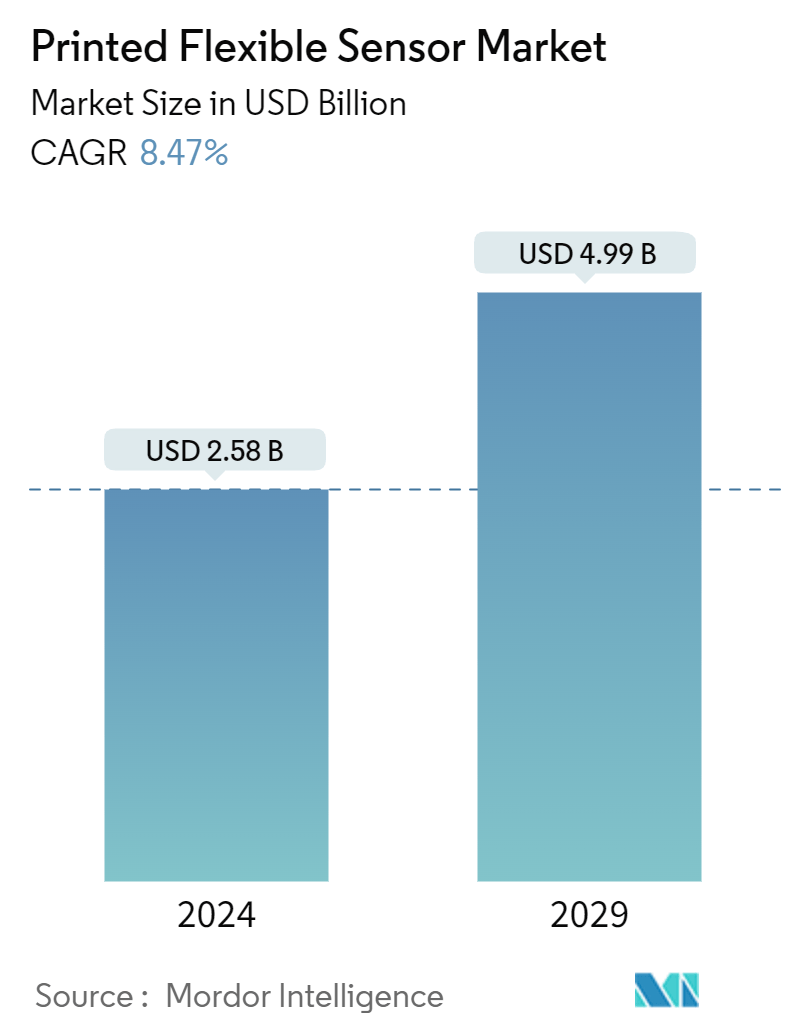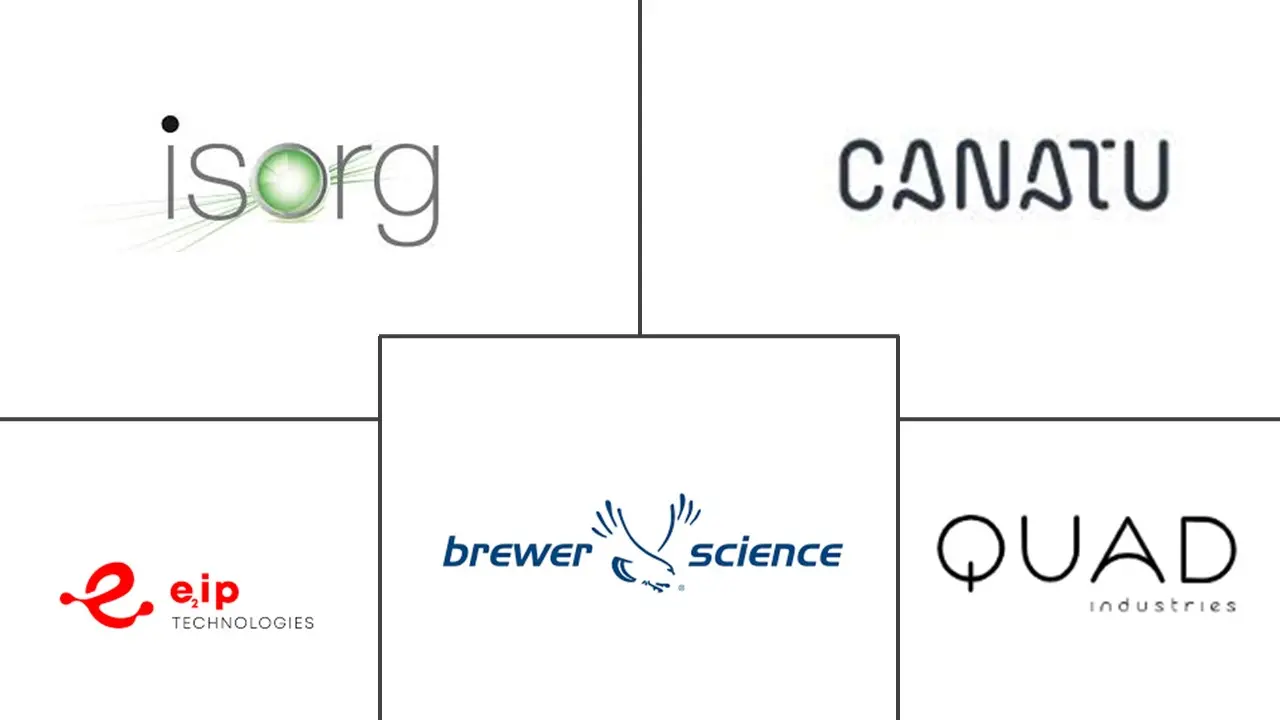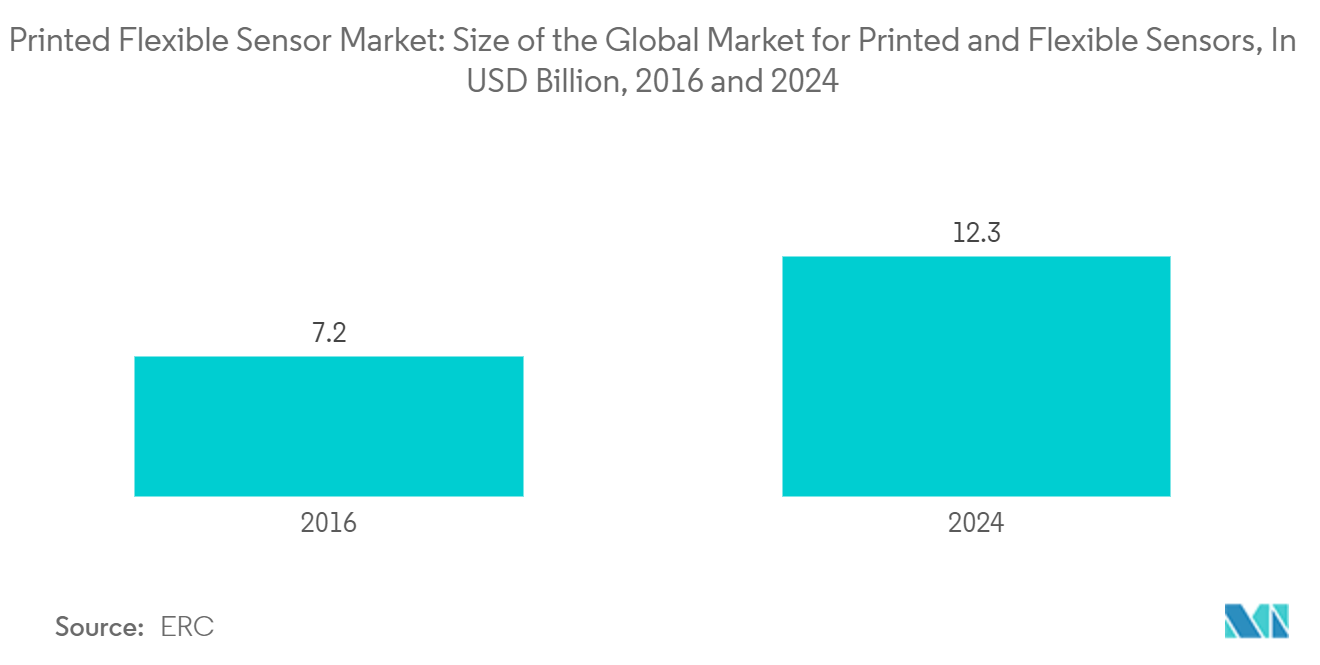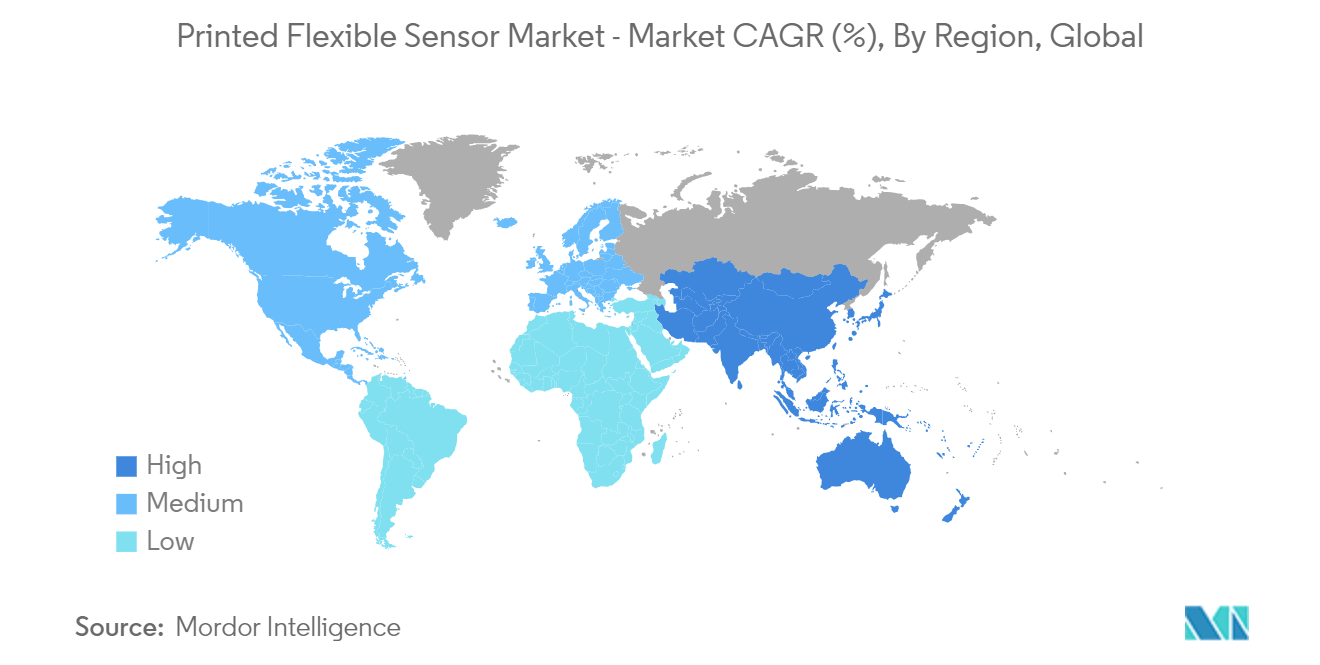Printed Flexible Sensor Market Size

| Study Period | 2019 - 2029 |
| Market Size (2024) | USD 2.58 Billion |
| Market Size (2029) | USD 4.99 Billion |
| CAGR (2024 - 2029) | 8.47 % |
| Fastest Growing Market | Asia Pacific |
| Largest Market | North America |
Major Players
*Disclaimer: Major Players sorted in no particular order |
Printed Flexible Sensor Market Analysis
The Printed Flexible Sensor Market size is estimated at USD 2.58 billion in 2024, and is expected to reach USD 4.99 billion by 2029, growing at a CAGR of 8.47% during the forecast period (2024-2029).
- Printed and flexible electronics use advanced electronic printing methods to create devices such as sensors on different substrates. The inks, substrate, and printing techniques create a unique technology, allowing greater flexibility, lower cost of ownership, and speed.
- In recent decades, the development of organic semiconductors, conductive polymers, amorphous silicon, and conductive inks has led to huge strides toward processability and flexibility. Thus, these materials have become the base for the development of printed and flexible electronic devices, such as sensors, in applications that require rolling, bending, folding, and stretching, among other properties that conventional electronics find hard to fulfill.
- A significant driving factor behind the market's growth is the progression in demand for energy-efficient, thin, and flexible consumer electronics products. The trend of miniaturization is becoming prevalent across various end-user industries, such as consumer electronics, medical devices, and automotive, which is another major factor expected to positively influence the growth of the market. In the next few years, the prices of printed and flexible sensors are anticipated to decline owing to further development in material types and advancements in manufacturing processes, which are also likely to enhance the market's growth.
- Over the years, the penetration of consumer electronic products has increased significantly. Urbanization, changing lifestyles, the growing demand for convenience products, and technological advancement bringing the price of consumer products down are among the major factors driving this growth.
- With the development of disciplines such as material and control science and communication technology, there has been a series of breakthroughs in flexible sensors. These sensors have achieved multi-directional information acquisition capabilities and the ability to maintain excellent performance in complex environments, with varying degrees of sensitivity, detection ranges, and minimum detection values.
- Additionally, the development of adaptive, implantable, and degradable materials and the emergence of self-powered bio-cells have led to the emergence of a wide range of flexible and printed sensor devices. Textile-based wearable activity sensors such as pressure and strain sensors were developed to monitor various health-related biometric parameters due to their unique properties and portability.
- Furthermore, the market players frequently develop new products to expand their reach into new markets. For instance, in February 2023, Brewer Science Inc. announced the launch of hybrid printed sensors for efficient, real-time water quality monitoring to measure lead, nitrate, and pH at LOPEC in Germany. These sensors are made possible by combining printed electronics with next-generation materials. The result is a real-time continuous monitoring platform that can leverage multi-sensor arrays and associated multi-faceted sensor solutions.
Printed Flexible Sensor Market Trends
The Medical and Healthcare End-user Industry is Expected to Witness Growth
- Printed electronics is an innovative, constantly evolving, and improving technology that has revolutionized the design and production of medical devices and sensors. Advanced printed sensors can sense multiple parameters simultaneously, offering multimodal sensing capabilities. For example, a single sensor can measure temperature and pressure, comprehensively assessing a patient's condition.
- The medical and healthcare end-user industry is one of the prominent consumers of the printed and flexible sensors market. The advent of agile procedures, digital technologies, and seamless techniques in the industry has forced the players to shift their focus toward advanced and smart sensor technology. Printed and flexible sensors are widely used in the industry as they are arranged on a patient's body and can be used to closely monitor the patient's physiological condition. These sensors are used in electronic skin patches to track vital biometric parameters such as heart rate, respiration rate, muscle activity, temperature, and movement.
- Printed and flexible sensors are eco-friendly in nature and have the ability to fit onto various small, differently shaped electronic medical devices. The demand for biosensors is expected to grow in the medical and healthcare end-user industry as they can measure the reaction between a bodily fluid and an enzyme, such as a blood glucose strip for diabetes patients. Moreover, this sensor can be used to gather information from saliva, sweat, and blood. Temperature sensors help detect the change in the electrical signal of the thermos-sensitive material in response to a change in temperature.
- Printed sensors with wireless communication capabilities can transmit real-time data to healthcare providers, enabling remote patient monitoring. This breakthrough expanded the capabilities of telemedicine and improved patient care, particularly in remote or home care settings.
- Printed electronics can be easily integrated with other components, such as microcontrollers or batteries, increasing the overall functionality of printed sensors. This integration enables the development of more complex and versatile medical devices.
- Printed sensors can be designed for both long-term use and single-use applications, the latter of which is widely used in healthcare to reduce the risk of infection and prevent the transmission of pathogens. The materials used in disposable sensors are non-toxic and easily biodegradable, making them cost-effective and environment-friendly.

Asia-Pacific Holds a Dominant Position in the Market
- Asia-Pacific comprises China, Japan, South Korea, Singapore, India, Australia, and the Rest of Asia-Pacific. Asia-Pacific customers are accustomed to utilizing flexible displays, driving the demand for innovative, flexible products, including smartphones, tablets, PCs, and other gadgets. Printed and flexible sensors that can efficiently detect a range of stimuli associated with certain biological or environmental species have gained substantial attention from academics in recent years due to their huge potential for wearable electronics and Internet of Things (IoT) applications. The market is thus expected to grow rapidly during the forecast period.
- Consumer electronics is one of the major end-user industries in the region. The growth of the smartphone industry, the increasing adoption of smart and wearable devices, and the growing penetration of consumer IoT devices are important factors promoting the development of consumer electronics.
- China is also among the major markets for consumer electronics, wherein the proliferation of smart devices is driving the demand for printed flexible sensors. According to the National Bureau of Statistics of China, in November 2023, the country's retail sales revenue for consumer electronics and household appliances stood at CNY 94.61 billion (USD 13.3 billion).
- Flexible and printed sensors have already begun to appear in daily life. For instance, printed aerials for automobiles, smart textiles with pressure sensors to identify seat occupancy, and medical test stripes with diagnostic electrodes are some examples. In accordance with that, researchers at the University of Tokyo developed an optoelectronic skin with an ultra-thin, flexible LED display that can be worn on the back of the hand.
- In automotive, printed sensors are particularly important for monitoring e-mobility and battery status. Also, by integrating pressure sensor films into car seats, artificial intelligence and pattern recognition can be used to distinguish between people and other objects. This driver presence information forms the basis for various safety systems and driver assistance, such as seat belt warnings and emergency call systems in the event of an accident.
- According to data published by the Japan Automobile Dealers Association and the Japan Light Motor Vehicle and Motorcycle Association, in 2023, 43,991 standard-size EVs and 44,544 electric versions of Japan's signature lightweight kei minicars were sold. The ratio of EVs to total car sales was 1.7% for standard-size vehicles and 3.3% for kei cars, up from 1.4% and 2.2%, respectively, in 2022. This increasing adoption trend for electric vehicles will boost the growth of the printed and flexible sensor market in the region during the forecast period.

Printed Flexible Sensor Industry Overview
The printed flexible sensor market is semi-consolidated and consists of a few significant players. In terms of market share, few major players currently dominate the market. Various companies are focusing on organic and inorganic growth strategies such as product launches, product approvals, patents, acquisitions, and partnerships. These influential players with a noticeable share in the market are concentrating on expanding their customer base across foreign countries. They are also leveraging strategic collaborative actions to improve their market percentage and enhance their profitability.
- March 2024: Naxnova announced the acquisition of Quad Industries for INR 90 crore (USD 10.85 million), which aims to strengthen product offerings for the automotive industry. Through this acquisition, Quad expanded its activities in the field of printed electronics so that it can provide these sectors with innovative, flexible sensor solutions.
- February 2024: Tekscan announced the release of a new pressure sensor specifically tailored to the challenges of interfacial pressure measurement in battery research, development, and manufacturing. This system provides customers with actionable information by identifying potential battery design issues, resulting in better, more reliable, and safer energy storage.
Printed Flexible Sensor Market Leaders
-
Canatu Oy
-
Brewer Science
-
ISORG
-
E2IP Technologies
-
Quad Industries
*Disclaimer: Major Players sorted in no particular order

Printed Flexible Sensor Market News
- April 2023: E2ip Technologies announced the completion of a USD 120 million growth funding round. Through this investment, the company was expected to become in HMI and IIoT Technology and increase its global revenue through the digital deployment of its products and ready-to-use printed electronics, touch-screen, embedded systems, and in-mold-electronics platform. It is also expected to expand its embedded systems capabilities in its existing high-volume facility in Casablanca, Morocco. The Canadian office will be consolidated into a new integrated manufacturing R&D facility in Montreal.
- February 2023: Quad Industries announced that it would introduce its newest developments in capacitive touch controls, medical electrode patches, printed flexible circuits, pressure sensors, PTC, and non-PTC stretchable film heaters at the LOPEC 2023 trade fair held in Germany.
Printed Flexible Sensor Market Report - Table of Contents
1. INTRODUCTION
- 1.1 Study Assumptions and Market Definition
- 1.2 Scope of the Study
2. RESEARCH METHODOLOGY
3. EXECUTIVE SUMMARY
4. MARKET INSIGHTS
- 4.1 Market Overview
- 4.2 Industry Value Chain Analysis
-
4.3 Industry Attractiveness - Porter's Five Forces Analysis
- 4.3.1 Threat of New Entrants
- 4.3.2 Bargaining Power of Buyers/Consumers
- 4.3.3 Bargaining Power of Suppliers
- 4.3.4 Threat of Substitute Products
- 4.3.5 Intensity of Competitive Rivalry
- 4.4 Impact of COVID-19 Aftereffects and Other Macroeconomic Factors on the Market
5. MARKET DYNAMICS
-
5.1 Market Drivers
- 5.1.1 Progression in Demand for Energy-efficient, Thin, and Flexible Consumer Electronics Products
- 5.1.2 Rising Integration of Printed Sensors in Medical Wearable Devices
-
5.2 Market Restraint
- 5.2.1 Requirement of Technological Improvements for Wider Adoption
-
5.3 Market Opportunities
- 5.3.1 IoT to Open Up New Growth Opportunities
- 5.3.2 Expanding Adoption of Touch-enabled Electronic Devices
6. MARKET SEGMENTATION
-
6.1 Type
- 6.1.1 Biosensor
- 6.1.2 Touch Sensor
- 6.1.3 Photodetectors
- 6.1.4 Temperature Sensor
- 6.1.5 Pressure Sensor
- 6.1.6 Other Types
-
6.2 End-user Industry
- 6.2.1 Automotive
- 6.2.2 Consumer Electronics
- 6.2.3 Medical and Healthcare
- 6.2.4 Defense and Aerospace
- 6.2.5 Other End-user Industries
-
6.3 Geography***
- 6.3.1 North America
- 6.3.2 Europe
- 6.3.3 Asia
- 6.3.4 Australia and New Zealand
- 6.3.5 Latin America
- 6.3.6 Middle East and Africa
7. COMPETITIVE LANDSCAPE
-
7.1 Company Profiles*
- 7.1.1 Canatu Oy
- 7.1.2 Brewer Science
- 7.1.3 ISORG
- 7.1.4 E2IP Technologies
- 7.1.5 Quad Industries
- 7.1.6 Pressure Profile Systems Inc.
- 7.1.7 Butler Technologies Inc.
- 7.1.8 Tekscan Inc.
- 7.1.9 PST Sensors
- 7.1.10 PolyIC GmbH & Co. KG
- 7.1.11 Memtronik
- 7.1.12 Linepro Controls Pvt. Ltd
- 7.1.13 Forciot
- 7.1.14 Nissha Co. Ltd
8. INVESTMENT ANALYSIS
9. MARKET OPPORTUNITIES AND FUTURE TRENDS
** Subject To AvailablityPrinted Flexible Sensor Industry Segmentation
Sensors that are printed on flexible substrates signify a growing market. While some may consist of a very simple structure with only a few electrodes, others are much more complicated and need the deposition of many layers. They have in common the ability to be printed on plastic substrates, which offers them benefits in terms of mechanical flexibility, thinness, and weight decrease.
The printed flexible sensor market is segmented by type (biosensor, touch sensor, photodetectors, temperature sensor, pressure sensor, and other types), end-user industry (automotive, consumer electronics, medical and healthcare, defense and aerospace, and other end-user industries), and geography (North America, Europe, Asia-Pacific, Latin America, and the Middle East and Africa). The report offers the market sizes and forecasts for all the above segments in value terms (USD).
| Type | Biosensor |
| Touch Sensor | |
| Photodetectors | |
| Temperature Sensor | |
| Pressure Sensor | |
| Other Types | |
| End-user Industry | Automotive |
| Consumer Electronics | |
| Medical and Healthcare | |
| Defense and Aerospace | |
| Other End-user Industries | |
| Geography*** | North America |
| Europe | |
| Asia | |
| Australia and New Zealand | |
| Latin America | |
| Middle East and Africa |
Printed Flexible Sensor Market Research FAQs
How big is the Printed Flexible Sensor Market?
The Printed Flexible Sensor Market size is expected to reach USD 2.58 billion in 2024 and grow at a CAGR of 8.47% to reach USD 4.99 billion by 2029.
What is the current Printed Flexible Sensor Market size?
In 2024, the Printed Flexible Sensor Market size is expected to reach USD 2.58 billion.
Who are the key players in Printed Flexible Sensor Market?
Canatu Oy, Brewer Science, ISORG, E2IP Technologies and Quad Industries are the major companies operating in the Printed Flexible Sensor Market.
Which is the fastest growing region in Printed Flexible Sensor Market?
Asia Pacific is estimated to grow at the highest CAGR over the forecast period (2024-2029).
Which region has the biggest share in Printed Flexible Sensor Market?
In 2024, the North America accounts for the largest market share in Printed Flexible Sensor Market.
What years does this Printed Flexible Sensor Market cover, and what was the market size in 2023?
In 2023, the Printed Flexible Sensor Market size was estimated at USD 2.36 billion. The report covers the Printed Flexible Sensor Market historical market size for years: 2019, 2020, 2021, 2022 and 2023. The report also forecasts the Printed Flexible Sensor Market size for years: 2024, 2025, 2026, 2027, 2028 and 2029.
Printed Flexible Sensor Industry Report
Statistics for the 2024 Printed and Flexible Sensors market share, size and revenue growth rate, created by Mordor Intelligence™ Industry Reports. Printed and Flexible Sensors analysis includes a market forecast outlook 2029 and historical overview. Get a sample of this industry analysis as a free report PDF download.



